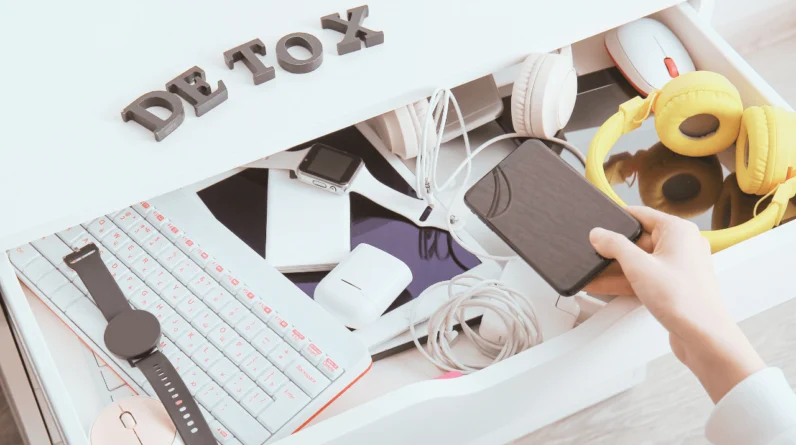
The average person checks their phone 144 times per day. On top of this, most of us spend over four hours on our phones each day—about one full day per week!
We’re more connected than ever before, yet more distracted, too. I still remember when phones were just for calls and the occasional text. Flip phones with grainy cameras, slow browsers that cost 10 to 50 cents to load a page—simple times when being “online” wasn’t a full-time job.
Now, however, our phones have become extensions of ourselves—an alarm clock, calendar, camera, social lifeline, and entertainment hub all in one. But the problem isn’t just how much time we spend on them; it’s also how seamlessly they’ve woven themselves into every corner of our lives.
And without clear digital boundaries, it’s easy to lose focus, rest, and even our sense of presence in the real world. This often compounds, leading to poor mental health, isolation, and more. It’s no secret that mental illness has been on the rise in recent years.
Thus, screen time management has become increasingly important as our lives continue to intertwine with our digital devices. Whether you’re a busy parent, remote worker, or a regular social media user looking to cut back, this guide will help you set real digital boundaries that stick.
After all, technology isn’t the enemy—it’s how we use it that matters the most. With the right strategies, tools, and mindset, you can reclaim your time, attention, and peace of mind without having to completely disconnect.
How Do You Know If You Need to Set Digital Boundaries?
Picking up our phones and checking each social media app has become the norm.
You see people do it mid-conversation, without a second thought, and many (including myself) have been guilty of scrolling into the late hours of the evening/early hours of the morning and first thing in the morning—even though we know we shouldn’t.
But there are a few clear signs it could be becoming a problem in your life and interfering with your mental health, such as:
- Increased irritability
- Fear of Missing Out (FOMO)
- Checking your phone mid-activity or mid-conversation
- Feeling more anxious
- Feeling guilty when not online
- Disrupted or poor sleep
- Having a hard time relaxing without your phone nearby
- Experiencing mood swings with different notifications
- Losing track of time when scrolling
- Comparing yourself to others online
- Neck pain or eye strain from digital device use
And while you may have tried setting boundaries regarding your digital devices in the past, there’s often a reason they don’t work.
Why Do Traditional Boundaries Often Fail in the Digital Age?
Modern technology is built to capture and hold attention (And if you haven’t seen it, I highly recommend Netflix’s documentary The Social Dilemma). Notifications, infinite scrolling, and the fear of missing out (FOMO) all tap into deep psychological triggers that make unplugging feel almost impossible.
And this is why setting boundaries that depend on discipline alone rarely work.
Hard boundaries, on the other hand, create real separation. These types of boundaries may include setting scheduled offline hours, keeping devices out of the bedroom, or turning notifications completely off during family time.
So, let’s take a closer look! What specific types of digital boundaries should you set?
5 Types of Digital Boundaries
Digital boundaries take on many forms. And knowing the different types can set you up for success; they include:
1. Time Boundaries
Time boundaries manage when and how long you engage with screens. This might include setting app timers, defining specific “offline hours,” or using Do Not Disturb mode during meals and family time.
For remote workers, creating a digital shutdown ritual after work—such as closing your laptop and stepping away from your workspace—further signals to your brain that the day is over.
2. Space Boundaries
Space boundaries separate your physical environment from your digital one to improve focus and rest.
For instance, keeping your devices out of the bedroom helps preserve it as a sanctuary for sleep. No phones at the dinner table protects meaningful connection time.
You may also want to consider “charging baskets” for your family. This is where all devices stay during designated hours to encourage real-world interaction and family time. For example, a great time to use this is during family dinnertime.
3. Emotional Boundaries
Emotional boundaries protect your mental and emotional energy from online overload. This can take on various forms, such as unfollowing stress-inducing accounts (I actively do this every few months!), limiting doom scrolling, and reducing how often you engage in arguments or heated comment threads.
Always keep in mind that you control what you consume—and what you allow to affect you. If you find yourself getting worked up about a certain account, the unfollow or mute button can work wonders here! Additionally, you control your thoughts, so choose them wisely; this can help prevent downward spirals triggered by what you see online.
4. Informational Boundaries
Informational boundaries mean being deliberate about what information you take in and what you share.
Curate your news intake and try batch checking—reviewing emails or headlines at set times instead of refreshing throughout the day.
It can also help to reassess your privacy settings and be mindful about what you post and who can see it.
If you really find the news brings you down, there’s also no shame in deleting any news apps. I did this years ago, and it was such a relief. Anything you must know, you’ll hear about, such as through close personal friends, colleagues, or loved ones (or even other apps!).
5. Social Boundaries
Social boundaries define how and when you interact with others online. This might mean muting group chats that constantly buzz or setting a clear cut-off time for work messages—such as no Slack or email replies after 7 pm.
And keep in mind that you never have an obligation to answer texts or messages straight away.
This never used to be the case; for instance, when everyone had landlines, you could only get hold of someone when they were home or if they called you back after leaving a voice message.
Platform-Specific Strategies for Social Media Boundaries
Social media boundaries often fail simply because these apps are made to draw us in.
I’m sure we’ve all had the experience where we intend to spend a mere couple of minutes on one app, only to realize it’s been 30 minutes of scrolling, and it’s essentially been wasted time.
So, here are more specific strategies for each of the popular platforms:
While mentioned above, here’s another reminder: mute accounts that trigger comparison or stress—you can do this without unfollowing. Limit who can see your stories to close friends only, and set designated “posting windows” instead of checking the app throughout the day.
Related Article: Your Brain on Instagram: Why Social Media Hijacks Your Happiness
TikTok
Use the built-in screen time reminders—and actually stop when they appear.
Disable autoplay on the “For You” page to avoid endless scrolling, and unfollow trending content that drains your energy, even if it’s popular.
Facebook & Threads
Adjust your notifications to the essentials only—like comments on your posts or messages from close friends. Turn off everything else to reduce distraction and reclaim your attention.
YouTube
Create watchlists for videos you genuinely want to watch rather than browsing aimlessly. Setting clear start and stop times helps you enjoy content intentionally, rather than letting the algorithm’s endless queue take over.
Related Article: Digital Detox Challenge: Put Down Your Devices!
Work & Productivity Apps (Slack, Teams, Email)
Turn off push notifications after work hours to protect your personal time. Use status messages strategically—such as “Heads down until 2 pm” or “Checking messages at 10 am, 2 pm, and 4 pm only.” Batch communication by checking messages at set intervals rather than staying in reactive mode all day.
For example, I often only check email at the start of my day, before my lunch break, and when I close off work. This ensures I get back to everyone in a timely manner, but also that it doesn’t pull me away from more focused work.
The 30-Day Digital Boundary Reset
Ultimately, setting digital boundaries that stick requires a structured approach. And this four-week framework can help you build sustainable habits, ensuring you’re protecting your mental health and not constantly getting sucked into digital distraction.
Week 1: Gain Awareness
Track your screen time using tools like Screen Time (iOS), Digital Wellbeing (Android), or RescueTime. This can bring how much time you actually spend on certain apps to the forefront.
You may also want to journal about what feels most draining. Are you losing hours to specific apps? Do certain times of day trigger more scrolling? Awareness without judgment is the foundation.
Week 2: Simplify Your Digital Life
Declutter your digital life ruthlessly.
Unsubscribe from newsletters you never read. Delete apps you don’t use. Clean up your home screen so only intentional tools are visible. Mute every non-essential notification. This helps create friction between you and time-wasting apps.
Week 3: Rebuild
Introduce intentional habits.
Schedule screen-free blocks—even just for 30 minutes. Create morning and evening tech routines; this might mean no phone for the first hour after waking, or letting your devices “charge” in another room 30 minutes before bed.
Replace scrolling triggers with alternatives, such as keeping a book nearby to reach for when bored, as opposed to your phone.
Week 4: Reinforce Your Boundaries and Adjust
Assess what’s working and what needs adjustment.
Which boundaries feel natural now? Which ones need more support?
Plan ongoing check-ins—a weekly digital audit every Sunday can help you better understand how well you’re following your own boundaries and where adjustments may need to be made.
You may even want to consider finding an accountability partner. A friend or your partner can be a great support in this arena; maybe you’ll even want to set boundaries together!
Level Up Down the Road
Once you’ve completed your 30-day reset, keep in mind that technology itself can be part of the solution. The right tools can help reinforce the habits you’ve built and keep distractions in check.
Apps, such as Forest and Freedom, block distracting sites during focus periods.
Meanwhile, Headspace and Calm provide guided meditations to ease digital overwhelm.
Habitica turns habit-building into a fun, game-like experience, and tools like Notion or Trello let you visually track your progress and check things off as you go.
For parents managing family screen time, platforms like Google Family Link and Apple Family Sharing offer age-appropriate settings, time limits, and shared accountability, helping everyone in the household stay more mindful of their digital habits.
With the right mix of awareness, structure, and supportive tools, your relationship with technology can shift from draining to empowering. And in turn, your screen time starts serving your life, not the other way around.
Reclaiming Your Life in a Hyperconnected World
Digital boundaries aren’t about rejecting technology; this would be a tricky feat to achieve in today’s digital world!
Instead, they’re about reclaiming intentional use. When done right, boundaries improve focus, deepen relationships, enhance creativity, and restore peace of mind.
The truth is that our digital devices aren’t going anywhere any time soon. But your relationship with them can change. Start with one boundary this week—just one.
Turn off notifications during dinner. Leave your phone out of the bedroom. Check email twice a day instead of twenty times.
Your attention, your energy, and your life are worth protecting. Start your 30-Day Boundary Reset today!
Read Next: How to Stop Doomscrolling & Create Healthier Bookends for Your Day







